what do we want to be when we grow up?
- Written by Julianne Schultz, Founding Editor of Griffith REVIEW; Professor, Griffith Centre for Social and Cultural Research, Griffith University
For the most formative years of my childhood I lived in the western district of Victoria. You may recall the evocative paintings of Eugene von Guerard of this area. At the time I lived there, the western district was one of the wealthiest parts of the country. The wool boom meant that the farmers with the biggest spreads and fleeciest merinos would get huge cheques for their production – at their peak these cheques could be up to a million pounds, tens of millions of dollars in today’s coin.
My father was a Lutheran minister, and the farmers in his congregation were not the descendants of the squatters. Yet they still had sufficient land to be rich enough to ensure that throughout the 1960s the churchyard was full of lairy coloured cars with big fins – gorgeous, petrol guzzling monsters parked under the Cyprus trees every Sunday.
This area was wealthy for a reason. The volcanic plains had produced extraordinarily fertile soils. Millions of years after the last volcano had erupted, the residue of lava rocks, pockmarked like Aero chocolate bars, still littered the country. Many had been formed into fences and foundations. It was windy, wet, hilly and lush with lakes and streams – the Grampians looming on the horizon and long extinct volcanoes popping out of the plains.
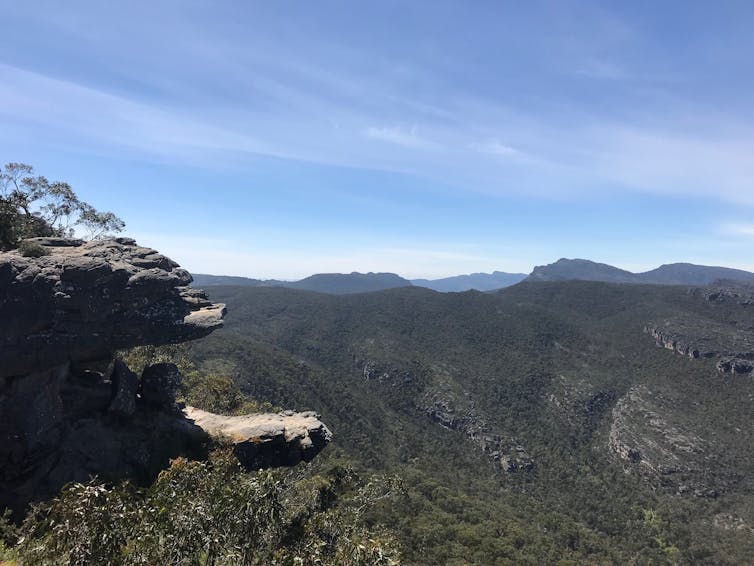 A general view of the Balconies lookout at the Grampians National Park, Victoria.
Pablo Mena/AAP
A general view of the Balconies lookout at the Grampians National Park, Victoria.
Pablo Mena/AAP
The descendants of the squatters had substantial houses, and soldier settlers eked out an existence on plots of land that were too small, except in the very best of times, to produce enough to support a family.
I was a curious child free to roam the country roads and lanes on my bike; to explore, pick mushrooms, fruit and wild flowers, watch shearers and harvesters at work; and wonder about what had happened before. At the edge of the pine-enclosed hamlet where we lived, which included two bluestone churches - the older one re-purposed as a classroom - a memorial school and hall, manse, teacher’s house, footy oval, timber bell tower and car park, there was a cemetery where people had been buried since 1861.
I probably spent more time than would be recommended for children today in that graveyard, wondering about the many lives cut short by the Spanish flu, about the children who died in infancy, the extended families in shared plots, and the old men and women born in faraway places and buried there.
But my favourite pastime was to ride along the roads and across paddocks to find the remnant sites of disused farms and houses, to pace out the stone foundations, to pick what would now be heritage plums and apples from the gnarled fruit trees in long forgotten orchards, to imagine life for the settlers, the religious obsessives who set up intentional communities, scrapping tribes whose different theological interpretations of the same text meant they could hardly bring themselves to talk to each other.
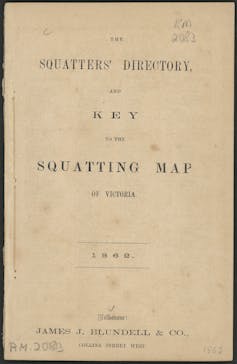 The Squatting Map of Victoria, Port Phillip District, New South Wales.
National Library of Australia
The Squatting Map of Victoria, Port Phillip District, New South Wales.
National Library of Australia
What was missing was any sense of anyone being there between the time the volcanoes erupted and the squatters arrived in the 1830s. I had a feeling for the country, for the plants and wildlife, but despite being vaguely aware of reserves near the coastal towns, I had absolutely no sense of Aboriginal occupation, or of the murderous battles they fought against the encroaching settlers.
As a daughter of the Lutheran church I knew about Aboriginal missions in Hermansburg and elsewhere in Central Australia and the outer reaches of NSW and Queensland.
But I had absolutely no understanding that these fertile lands once known as Gariwerd had been the preserve of the Jardwadjali and Djab Wurrung peoples for tens of thousands of years, that they had built sustainable settlements, trapped fish, husbanded the land, caught kangaroo, yabbies and eels, and made cloaks from possum skins to protect from the fierce winter chill.
We now know much more, the richness of the Indigenous cultural heritage in this part of Victoria is what you would expect for such fertile lands. As two great humanities scholars Bill Gammage and Bruce Pascoe have demonstrated in recent years in The Biggest Estate on Earth and Dark Emu, this was known since earliest European settlement.
Read more: Friday essay: Dark Emu and the blindness of Australian agriculture
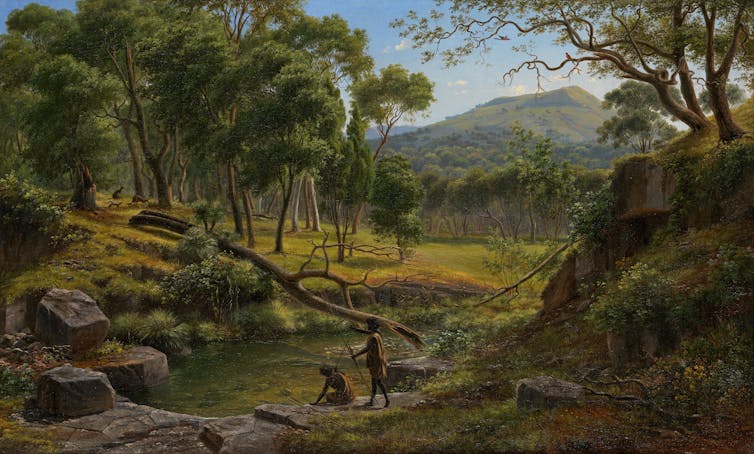 Eugene von Guerard, Warrenheip Hills near Ballarat, 1854.
Wikimedia Commons
Eugene von Guerard, Warrenheip Hills near Ballarat, 1854.
Wikimedia Commons
Some of the uniqueness of the local civilization was captured by the artists, the explorers, the anthropologists – those who asked the First Australians and those who looked, curious people deeply grounded in the skills of the humanities. Of course, many just took.
To paraphrase Henry Reynolds, Why wasn’t I told?
I well recall as a child of about ten going to the South Australian Museum on North Terrace in Adelaide with my grandparents who were conscientious members of the Lutheran community there with a sense of obligation to the church’s central Australian missions.
On this day we looked at the Aboriginal collections, and that museum had and still has an extraordinary collection. I recall seeing human skulls and not knowing how to process them. On the way out we passed an Aboriginal man. He moved, and whether I jumped, took a step sideways or some other reaction, I don’t recall, but I can feel the incident like it was yesterday and remember thinking: how can he be alive, we have just seen the exhibition, they are all dead.
They weren’t of course, a fact that has shaped political debate in this country with increasing sharpness ever since.
It took a while, but again the legacy of researchers – anthropologists, theologians, linguists, archeologists, historians and the increasingly important work of Indigenous scholars – has meant that the once blank slate of Australian history is now being filled with human beings doing the things that human beings do – making meaning, families, societies, tied to the land and climate.
I trust that before too long this important legacy will be a central part of our more grown up conversation.
A civics education
The pattern of life for a minister’s family was shaped by church, bible study, hymns and liturgies, and as insider outsiders, always watching, and knowing you were being watched. As a result, we learnt the tools of the humanities early, textual analysis before semiotics, theology before fundamentalism, history and geography when the Empire’s pink-coloured maps still prevailed, music as performed in churches and by great orchestras, human relations and morality from parables, psalms and creeds and the genealogical myths and stories in the Old and New Testaments.
My parents were young, highly educated in theology, music and languages. But it was an isolated, subsistence life: we grew our veges, milked cows, churned butter, collected eggs, chopped heads off chooks and plucked them, reared lambs and calves who went to the sale yard and came back as meat. I took my city-bred children back in 2011 for the 150th anniversary, and they freaked out. How could you have lived here? they asked.
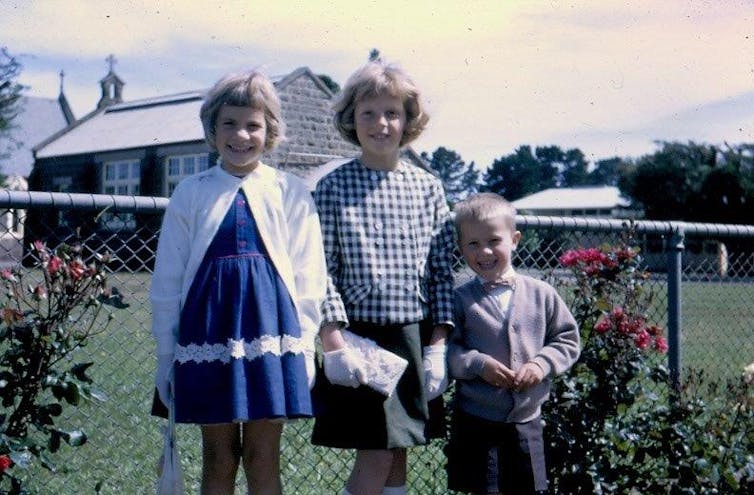 The author as a child, centre, with her sister Cindy and brother Andrew. Their school is in the background.
Author provided
The author as a child, centre, with her sister Cindy and brother Andrew. Their school is in the background.
Author provided
The key, I think, was my teacher in the tiny two-room school when I made it to the big school that had once been the church. As well as the SRI cards we worked through for most of our learning, he taught us about the world. I am grateful, we could have got a missionary zealot, but the shortage of teachers in the Lutheran system meant that they had to recruit abroad for Victorian School Number 84.
Jim Born and his wife arrived fresh from teacher’s college in Chicago. The impact of landing in this isolated countryside more than five hours drive from Melbourne must have been shocking. I remember him sitting in our kitchen with the cows on the other side of the fence outside the window describing how the L worked in Chicago: an above ground urban railway system filled with hundreds of people making connections, getting to and from work and school.
His great gift was to provide us in that sleepy backwater of conservative, blindfolded Victoria with a very American style civics education. He did this with an early form of what we would think of as media literacy education today. Every day we would get the Sun News Pictorial and sometimes The Age and The Herald and read the stories and cut up the papers and reassign them with different news orders – learning early that news is what the editor says it is. We learnt about headlines, subheads, news, comment, editorials, wire services, by-lines, the processes of reporting and making editorial judgements and producing newspapers.
Because this was during the 1960s, this meant learning about the Vietnam War, about civil rights, about protest, the last man hung in Victoria and the weekly death toll from car accidents.
When I have tried to pinpoint the founding impulse that made me decide to study journalism rather than medicine, after sweating over physics, chemistry and higher maths, I keep coming to this as the starting point.
Racial exclusion
One of the other dimensions of the Lutheran upbringing was about keeping a distance from public life. Germans had been coming to the Australian colonies since the early 1800s – religious exiles, intellectual leaders who shaped colonial debates, gold-diggers, missionaries, business men, artists and land-hungry farmers. One of the lessons of the two catastrophic world wars was to make those with German names cautious.
The internment process in Australia had been brutal and the legacy made even third and fourth generation Australians of German heritage nervous about putting their heads above the parapet. This was different to the tall poppy syndrome, it was a distinctive Australian racial typecasting and exclusion that still plays out today.
Read more: German experience in Australia during WW1 damaged road to multiculturalism
These days we might describe it as a fear of bullying. As some of the women in the Liberal party are deciding now, sometimes discretion is the better part of valour and it is wise to stay in the background. As a result, with the exception of the one man who was the mayor of nearby township, those of German descent were not active in public life – that was something for the descendants of the Scottish and English squatters, and the Catholics with Irish heritage in the unions and Labor Party. It took a long time before the benefits of multiculturalism opened the door to active participation in public life, even for people like me whose families had been in Australia since the mid 1800s.
The other formative element for me was the ABC. Over the middle years of childhood, I made the transition from the classical and mythical tales told in plummy accents on The Argonauts, which I used to listen to on my prized transistor sitting on the cattle grid that formed our gateway. First, to radio drama. Then and most importantly, my attention was drawn to This Day Tonight and Four Corners. Television also delivered Bellbird, Division 4, Jetsons, Bewitched, Hogan’s Heroes and my adolescent nemesis Sargent Schultz.
I then began to see that there was a world beyond the pine-rimmed compound, a world that people were actively imagining and deliberately making. It was clear that there was contest and protest, everything was not as it had always been. I could see that it was informed by history, political theory and philosophy, geography, religion, poetry, story-telling.
Underlying this was an undercurrent of attempts to develop a new Australian narrative, one that made more sense in the world that was being shaped in the wake of the second world war and the subsequent global realignment. As I heard my parents talk I knew that this quest was drawing many into its fold. Donald Horne’s Lucky Country was the standard bearer of many books published at this time, the product of a deliberate intervention by a group of like-minded people, and the sign of an antipodean cultural renaissance. By the end of the 1960s the population had almost doubled since the end of the war and reached 12 million.
Read more: Donald Horne's 'lucky country' and the decline of the public intellectual
There was no single magic bullet, many were involved, but again it was the tools of the humanities that were at the forefront.
A new narrative
Now I will jump forward to when I started at the University of Queensland and took advantage of the early fruits of what I can see now was a post-colonial project. I studied Australia – there were Australian studies majors in literature, history, politics and it was ever present in sociology and journalism.
This was the early flowering of a distinctive curriculum, it was grounded in broader intellectual traditions but it was about this place and its people, its institutions, its history and its culture. It was limited by the research that remained undone, and a lingering sense that Australia wasn’t really worth that much effort, it wasn’t really that interesting. Maybe so, but the accident of history that put us here meant it seemed to me at the time, and ever since, that it was worth interrogating.
 Our Svanen, the last of the Bicentennial timber tall ships used in 1988.
Sydney Harbour Tall Ships/AAP
Our Svanen, the last of the Bicentennial timber tall ships used in 1988.
Sydney Harbour Tall Ships/AAP
That interest in Australian studies coalesced around the bicentenary of British settlement in 1988. Large amounts of money were spent on research and publication, events and performances. Lingering blindness to the First Australians meant the tall ships and royals were centre stage, but many people wore black armbands to acknowledge the unspoken, grief laden history.
Not long afterwards the initial AIATSIS map of the more than 300 language groups of the First Australians was published and for the first time we worked our tongues around unusual names and we began to identify people by name, rather than by the capitalised use of a descriptor.
The challenge of creating a new narrative for Australia drew on the talents and energy of remarkable people – in the academy, in law, in politics, in the media, in science, business, the public service and an engaged public.
There were committees formed, policies implemented, research undertaken, newspapers published, radio and television programs broadcast, films produced, novels published – that found large national audiences and international acclaim. Without this scholarship and its associated activism the Mabo decision in 1993 would unlikely have been made. The judges drew on historical research to jettison the false notion of terra nullius.
What was happening here was also happening in many other countries as the ties of Empire were shredded, the umbrella of the post war global order created a space, need and opportunity to think about what made us and what this might mean.
The need for vigilance
In many ways, this reached its peak during the final years of Paul Keating’s prime ministership – and produced an equal and opposite reaction. Keating grabbed the opportunity of leadership to go higher up Maslow’s hierarchy of needs and seek to satisfy the more abstract desires in the apex of the triangle, confident that his economic reforms would deliver.
Australians, who by this time numbered 18 million, became more confident, more willing to own our past, creative, innovative, outward looking. At this time humanities and social science research was relatively well funded, universities were growing, the colonial past was a legacy we could examine, we were proud of what we had achieved and optimistic about where it might lead.
Yet just over a decade later when I was co-chairing the Creative Australia stream at the 2020 Summit in 2008 (by which stage the population numbered 21 million) I was taken aback to hear people younger than me saying that being Australian meant nothing to them, that they saw themselves as global citizens and being Australian was quite often an embarrassment, or somewhere to come home to for Christmas holidays.
Looking back, it is clear that the late 1990s was when we stalled and have been unable to get out of first gear ever since. At the end of the Keating years in 1996, I understood the desire by many Australians to slow down, to stop talking about ourselves, to just get on with things for a little while. Many thought it would be an opportunity to regroup and then come back to the next steps in the evolution of a national story with a larger and more diverse population and economy, to find a way of being that would be appropriate in the 21st century.
Instead a decade later we got the disastrous $180m tourism Australia campaign So Where the Bloody Hell Are You? – which not only reinforced the worst stereotypes drawn from an old notion of Australia, but was banned from British TV because of the language and had to be modified elsewhere because it caused offence.
In our eagerness to adopt the new economic models, which have served most of us remarkably well as Australia celebrates its 27th year of economic growth, we forgot to keep nurturing the cultural elements which form the fourth pillar of a successful society alongside people, land and economy, institutions and law.
Maybe we didn’t so much forget as get bullied out of it, or thought it was all settled and there was nothing more to do.
But just as those involved in arguing for a different understanding of what it meant to be Australian in the 1950s, 60s and 70s found, this is a long and protracted process that requires vigilance, persistence and creativity.
The people may be calling out for vision and leadership, but those who may lose power, status, position and influence as a result of a different sort of hierarchy will not give up without a fight, which can be aggressive or inert. The demographics are with us. Those interested in a shift in public discussion, party politics aside, are in the ascendancy. And there are now, with the population tipping 25 million, many more Australians than there were when this project commenced in the 1960s, many of whom for which this history is quite opaque.
Earlier I mentioned the role of the media in fostering a different sense of what it means to be Australian in my growing up. There is a rich history in this, a story for another day. Suffice to say, journalists, academics, politicians, policymakers, business people, writers, artists were active in developing new outlets and new ways of communicating what a different Australia might be like. Rupert Murdoch started The Australian, and a raft of other outlets flourished.
There were summer schools where journalists, policymakers and politicians met to debate the big issues. These were different times, the intersecting networks of elites, not then a dirty word, were smaller and more closely connected. There was contest and inevitably some enmity but a shared sense of nation-building.
This shared sense has now in been lost, which may be part of the answer to Frank Lowy’s question last week, Why are we so timid?
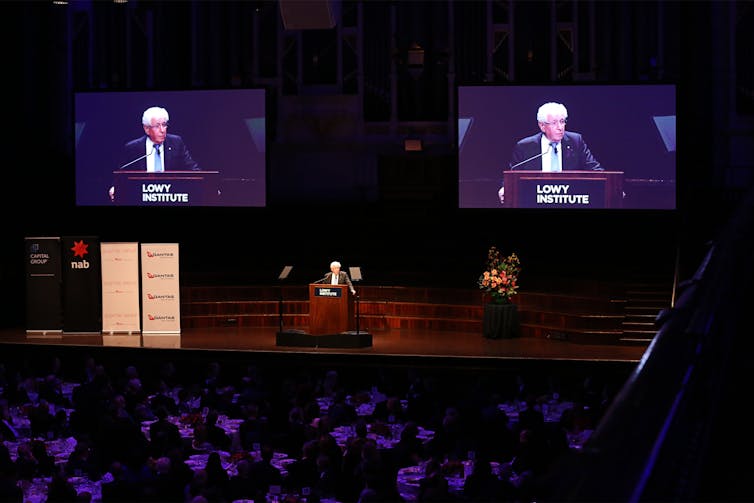 Lowy Institute Chairman, Sir Frank Lowy AC, delivering a lecture last week in which he expressed concern at the negative tone of the debate over immigration.
Danny Casey/AAP
Lowy Institute Chairman, Sir Frank Lowy AC, delivering a lecture last week in which he expressed concern at the negative tone of the debate over immigration.
Danny Casey/AAP
The once dominant ethos of outward-looking, innovative egalitarianism been replaced with inward-looking diffidence. Again, when we grow up I hope that this old ethos will prevail.
The transformation of the media has played a part in the loss of a shared ambition. Those with dissenting views are too quickly sidelined and attacked. In recent weeks the role of the media, and key individuals with access to the airwaves to influence and shape public debate, has been called out. Most notably by Malcolm Turnbull in his last stand in the prime minister’s courtyard at Parliament House, and by Chris Uhlmann on breakfast television.
The behaviour is not new, naming it is. This is a good sign we might have a more mature conversation in future, as once largely unspoken subjects move on to the agenda.
Queensland has frequently been the testbed for new arguments, new forms of organisation, new political approaches – good and bad and often tied to gender, but that too is another story. So not only did Pauline Hanson emerge from this state, but the campaign against Manning Clark a few months after the election of the Howard government did nothing to turn up the level of civilization.
Clark had died five years earlier, and despite all his faults he was widely regarded as a wise old man of Australia. Not everyone shared this view. Some decried his political influence, especially on Prime Minister Keating, others disputed his professionalism.
But to suggest that the most publicly recognised and eminent of Australian historians was an agent of Soviet Russia was breathtaking. Breathtakingly wrong as it turned out. The Press Council reached this conclusion in response to a complaint about the articles made by former Governor General Sir Zelman Cowan.
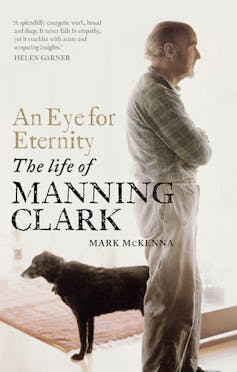 Clark’s biographer Mark McKenna attributes the campaign to “political envy” and that is as good an explanation as any. History had been politicised. Rather than senior academics being inside the club that actively discussed and debated questions of national identity the signal was clear that unless they shared particular ideological views they were no longer welcome.
Academics are not by nature people likely to take to the front lines, that is part of the reason we opt to research and teach, mostly we prefer quiet, private, measured occupations where the rules of the game are clearly defined by peer review, citation and grants. We are comfortable with ambiguity and complexity, very reluctantly condemning or praising.
In the two decades since this campaign began in earnest, scholars in the humanities and social sciences have continued to do their work, but with a wary eye to the public domain: will their work be derided as claptrap, subjected to nitpicking critiques of detail that wilfully misses the big picture. Public trust has been eroded.
‘Culture wars’
The notion of a culture war was imported to this country a couple of years after it gained political currency in the US. I am pretty sure it didn’t have the correct visa, but like rabbits, cane toads and prickly pears it has stuck around wiping out a lot in the process.
Values are the real target, but often they remain unnamed because the values under attack are those most hold dear – equality, human rights, respect for expertise, freedom of speech.
We share a lot, we are globally connected, but the pressure points here are different to those in the US, Britain and other countries with which we like to compare ourselves.
Religion, guns and abortion are not the issues here that they are in the US; class, inequality and migration are not the issues here that they are in Britain.
We have our own, and I will use a phrase I hate, “hot button” issues and they centre on race/settlement, environment/climate change, gender/women and universities.
Clark’s biographer Mark McKenna attributes the campaign to “political envy” and that is as good an explanation as any. History had been politicised. Rather than senior academics being inside the club that actively discussed and debated questions of national identity the signal was clear that unless they shared particular ideological views they were no longer welcome.
Academics are not by nature people likely to take to the front lines, that is part of the reason we opt to research and teach, mostly we prefer quiet, private, measured occupations where the rules of the game are clearly defined by peer review, citation and grants. We are comfortable with ambiguity and complexity, very reluctantly condemning or praising.
In the two decades since this campaign began in earnest, scholars in the humanities and social sciences have continued to do their work, but with a wary eye to the public domain: will their work be derided as claptrap, subjected to nitpicking critiques of detail that wilfully misses the big picture. Public trust has been eroded.
‘Culture wars’
The notion of a culture war was imported to this country a couple of years after it gained political currency in the US. I am pretty sure it didn’t have the correct visa, but like rabbits, cane toads and prickly pears it has stuck around wiping out a lot in the process.
Values are the real target, but often they remain unnamed because the values under attack are those most hold dear – equality, human rights, respect for expertise, freedom of speech.
We share a lot, we are globally connected, but the pressure points here are different to those in the US, Britain and other countries with which we like to compare ourselves.
Religion, guns and abortion are not the issues here that they are in the US; class, inequality and migration are not the issues here that they are in Britain.
We have our own, and I will use a phrase I hate, “hot button” issues and they centre on race/settlement, environment/climate change, gender/women and universities.
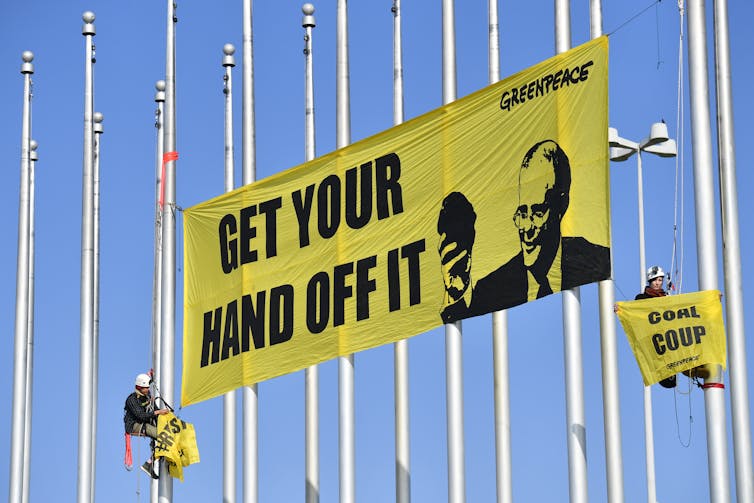 Greenpeace activists unfurl a banner on the flagpoles outside Parliament House in Canberra on September 10, depicting Scott Morrison holding a lump of coal.
Mick Tsikas/AAP
As the New York Times commentator David Brooks has observed, there is no point in having a culture war unless you know what you want the outcome to be. He argued that even as more and more people, especially children and young people, died from gun crime in the US, the outrage over gun control had been counterproductive – everyone was boxed into a corner and laws about the use and licensing of fire arms were weakened not strengthened.
In other regards he notes that those with a progressive perspective had won – the rights agenda has been expanded in ways that would once have been unimaginable – although whether this will still be the case at the end of the Trump presidency remains to be seen.
Within a couple of years of the American revival of the notion of a culture war, it snuck into public discussion here. Even before he became prime minister John Howard had adopted this approach to the values debate, especially focused on relations with the First Australians and the monarchy.
Those who had researched the history of settlement with care and diligence were described as black armband historians, a double-edged tag given the centuries-long history of a black armband as a signal of grief. Howard was a determined advocate and even in retirement has not given up. Universities have regularly been on his list, as we saw when he released the letter terminating the discussion with ANU about the possible Ramsay Centre for western civilization.
It is an approach that has served him well, but I think it has done the country a major, hopefully not irreversible, disservice.
There are plenty of others with megaphones who have joined the chorus, which of course pivots on race and settlement. Humanities scholars were an early target, then legal scholars and judges, environmental scholars and scientists: those who had researched the wars of settlement were first on the list, then those who had focused on multiculturalism, historic ties with Britain and then the critics stepped into once protected territory and science became a target as the existential threat of climate change challenged the established order.
The tone of public discourse has become so aggressive, nit picking and ideological there were few willing to engage. Even as the universities grew academics had been knocked of their pedestal. Like the descendants of the German settlers a century ago, many retreated. Who can blame them. Best to get on with what you do.
So to borrow David Brooks’ framing, what was the end point of this culture war, how would you know if it had been won?
Funding for humanities research has been stable, but it is thin, and has not been growing at the same rate as scientific and medical research; humanities departments have been closed in many universities; Australia is no closer to being a republic; there is no treaty with the First Nations, no representative body or Voice to Parliament; bullying has been mainstreamed; politicians confidently declare serious research claptrap and important tests to the constitution a lawyer’s picnic; legitimate refugees are held in intolerable conditions in settlements in former colonies; even as the evidence of climate change takes a visible toll we are urged to pray rather than do something; the old tropes around race, complacency, vulgarity have again become normal rather than the modern, inclusive, reconciled country on display at the opening ceremonies of the Commonwealth Games or Olympics.
Greenpeace activists unfurl a banner on the flagpoles outside Parliament House in Canberra on September 10, depicting Scott Morrison holding a lump of coal.
Mick Tsikas/AAP
As the New York Times commentator David Brooks has observed, there is no point in having a culture war unless you know what you want the outcome to be. He argued that even as more and more people, especially children and young people, died from gun crime in the US, the outrage over gun control had been counterproductive – everyone was boxed into a corner and laws about the use and licensing of fire arms were weakened not strengthened.
In other regards he notes that those with a progressive perspective had won – the rights agenda has been expanded in ways that would once have been unimaginable – although whether this will still be the case at the end of the Trump presidency remains to be seen.
Within a couple of years of the American revival of the notion of a culture war, it snuck into public discussion here. Even before he became prime minister John Howard had adopted this approach to the values debate, especially focused on relations with the First Australians and the monarchy.
Those who had researched the history of settlement with care and diligence were described as black armband historians, a double-edged tag given the centuries-long history of a black armband as a signal of grief. Howard was a determined advocate and even in retirement has not given up. Universities have regularly been on his list, as we saw when he released the letter terminating the discussion with ANU about the possible Ramsay Centre for western civilization.
It is an approach that has served him well, but I think it has done the country a major, hopefully not irreversible, disservice.
There are plenty of others with megaphones who have joined the chorus, which of course pivots on race and settlement. Humanities scholars were an early target, then legal scholars and judges, environmental scholars and scientists: those who had researched the wars of settlement were first on the list, then those who had focused on multiculturalism, historic ties with Britain and then the critics stepped into once protected territory and science became a target as the existential threat of climate change challenged the established order.
The tone of public discourse has become so aggressive, nit picking and ideological there were few willing to engage. Even as the universities grew academics had been knocked of their pedestal. Like the descendants of the German settlers a century ago, many retreated. Who can blame them. Best to get on with what you do.
So to borrow David Brooks’ framing, what was the end point of this culture war, how would you know if it had been won?
Funding for humanities research has been stable, but it is thin, and has not been growing at the same rate as scientific and medical research; humanities departments have been closed in many universities; Australia is no closer to being a republic; there is no treaty with the First Nations, no representative body or Voice to Parliament; bullying has been mainstreamed; politicians confidently declare serious research claptrap and important tests to the constitution a lawyer’s picnic; legitimate refugees are held in intolerable conditions in settlements in former colonies; even as the evidence of climate change takes a visible toll we are urged to pray rather than do something; the old tropes around race, complacency, vulgarity have again become normal rather than the modern, inclusive, reconciled country on display at the opening ceremonies of the Commonwealth Games or Olympics.
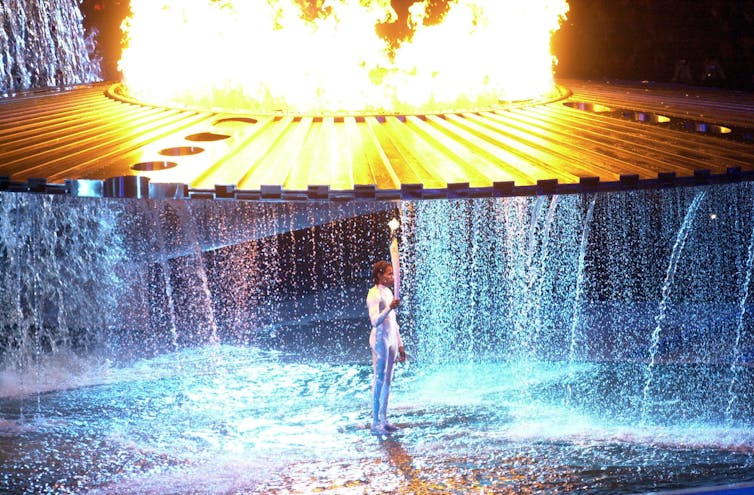 Cathy Freeman stands beneath the Olympic flame after lighting it at the 2000 Olympic Games Opening Ceremony in Sydney.
Dave Hunt/AAP
Every day there are people talking about the need for a new vision, but those in positions of political and public leadership duck and dodge these questions.
The much larger number of Australians are ready for a new grown up conversation. It is needed because the one that helped us step up decades ago doesn’t capture the complexity of contemporary life and the opportunities that accompany a society that is still growing and not locked in the past.
Meanwhile repeated calls for a new narrative, for a way of describing Australia in the world, fall on deaf ears. Australian Studies is no longer a research category. The last interdisciplinary Australian Studies Centre, at Monash, has become a virtual centre, although ANU has created a new institute. The Department of Foreign Affairs and Trade has belatedly decided to address the question of soft power, which by definition will require a contemporary national narrative.
We need a narrative that lasts longer than the cycle of an advertising campaign. Success is more likely to come with input from research, publication and debate of humanities scholars in conjunction with a wide network of others in the arts, business, media, public service and sciences, than from a brand agency.
Or the office of the new prime minister, the man behind the So Where the Bloody Hell Are you? campaign, who emulates a Pentacostal preacher using empty clichés and asking rhetorical questions and, unfortunately for those MPs who raised their hands, engaging in the call and response that features in that tradition. Politicians have generally followed on this important discussion, their ability to articulate mood and ambitions are important, depends on on the ground engagement.
Cathy Freeman stands beneath the Olympic flame after lighting it at the 2000 Olympic Games Opening Ceremony in Sydney.
Dave Hunt/AAP
Every day there are people talking about the need for a new vision, but those in positions of political and public leadership duck and dodge these questions.
The much larger number of Australians are ready for a new grown up conversation. It is needed because the one that helped us step up decades ago doesn’t capture the complexity of contemporary life and the opportunities that accompany a society that is still growing and not locked in the past.
Meanwhile repeated calls for a new narrative, for a way of describing Australia in the world, fall on deaf ears. Australian Studies is no longer a research category. The last interdisciplinary Australian Studies Centre, at Monash, has become a virtual centre, although ANU has created a new institute. The Department of Foreign Affairs and Trade has belatedly decided to address the question of soft power, which by definition will require a contemporary national narrative.
We need a narrative that lasts longer than the cycle of an advertising campaign. Success is more likely to come with input from research, publication and debate of humanities scholars in conjunction with a wide network of others in the arts, business, media, public service and sciences, than from a brand agency.
Or the office of the new prime minister, the man behind the So Where the Bloody Hell Are you? campaign, who emulates a Pentacostal preacher using empty clichés and asking rhetorical questions and, unfortunately for those MPs who raised their hands, engaging in the call and response that features in that tradition. Politicians have generally followed on this important discussion, their ability to articulate mood and ambitions are important, depends on on the ground engagement.
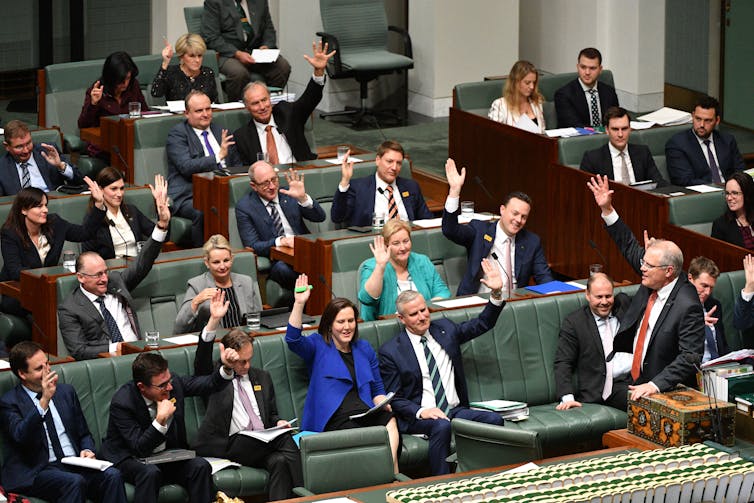 Raised hands in Parliament in response to a question from the Prime Minister, September 13.
Mick Tsikas/AAP
As Franklin Roosevelt said,
A nation must believe in three things. It must believe in the past. It must believe in the future. In must, above all, believe in the capacity of its own people so to learn from the past that they can gain in judgement in creating their own future.
The light has been turned on
Humanities scholars have a lot to contribute to this discussion and indeed to the broader global discussion, because the big issues today are global as well. The world of my childhood was probably scarcely different to that of countless children in country manses for generations. It was humanities research that dug deeper, that revealed what was hiding in plain sight on those basalt plains I used to ride over. Once the light is turned on it can’t be turned off, what has been seen can’t be unseen.
Now we need a new national narrative for reasons of diplomacy, trade and social cohesion. This will inform and shape the conversation we need to have if we are to grow up.
The world has changed since we last took this question seriously. We need to face up to the big global challenges with imagination, insight and ingenuity: the rise of China, climate change, globalisation, inequality, gender, threats to democracy and institutions, public morality and the ethical challenges of digitisation, artificial intelligence and genetic science.
The issues at stake now are monumental and call for a humanities response to be embedded in them. While the focus is on science and medical research the tricky bits are - as the New Yorker’s Evan Osnos wrote last week about the challenges facing Mark Zuckerberg – about our humanity, the nature of our civilization.
These are not technical puzzles to be cracked in the middle of the night but some of the subtlest aspects of human affairs, including the meaning of truth, the limits of free speech, and the origins of violence.
Raised hands in Parliament in response to a question from the Prime Minister, September 13.
Mick Tsikas/AAP
As Franklin Roosevelt said,
A nation must believe in three things. It must believe in the past. It must believe in the future. In must, above all, believe in the capacity of its own people so to learn from the past that they can gain in judgement in creating their own future.
The light has been turned on
Humanities scholars have a lot to contribute to this discussion and indeed to the broader global discussion, because the big issues today are global as well. The world of my childhood was probably scarcely different to that of countless children in country manses for generations. It was humanities research that dug deeper, that revealed what was hiding in plain sight on those basalt plains I used to ride over. Once the light is turned on it can’t be turned off, what has been seen can’t be unseen.
Now we need a new national narrative for reasons of diplomacy, trade and social cohesion. This will inform and shape the conversation we need to have if we are to grow up.
The world has changed since we last took this question seriously. We need to face up to the big global challenges with imagination, insight and ingenuity: the rise of China, climate change, globalisation, inequality, gender, threats to democracy and institutions, public morality and the ethical challenges of digitisation, artificial intelligence and genetic science.
The issues at stake now are monumental and call for a humanities response to be embedded in them. While the focus is on science and medical research the tricky bits are - as the New Yorker’s Evan Osnos wrote last week about the challenges facing Mark Zuckerberg – about our humanity, the nature of our civilization.
These are not technical puzzles to be cracked in the middle of the night but some of the subtlest aspects of human affairs, including the meaning of truth, the limits of free speech, and the origins of violence.
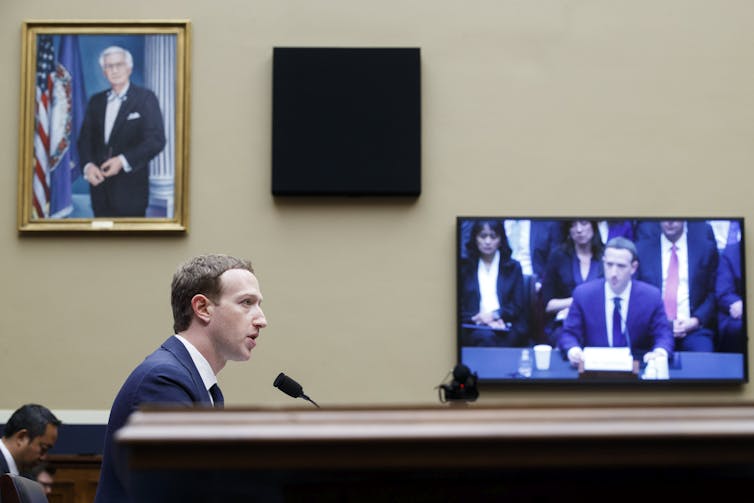 CEO of Facebook Mark Zuckerberg testifies before the House Energy and Commerce Committee hearing on ‘Facebook: Transparency and Use of Consumer Data’ in Washington, DC, 11 April 2018.
Shawn Thew/EPA
The perspective of the humanities and social sciences is not an adjunct to these hard questions. This is their bread and butter. They need to lead as well as fill in the human gaps. The insights from philosophy, history, literature are inextricably tied to questions arising from innovations in technology, medical research and economics.
The answers humanities scholars are likely to provide will be subject to contest, they will at times be ambiguous, but they are capable of transforming public understanding and action. We need projects as big as those that transformed our understanding of this country a few decades ago. That will take courage, imagination and resilience and a tentative vision of what a grown-up Australia might look like in the 21st century.
Unless you want everything to stay the same forever, this is not something to be afraid of. That, I think, has been the purpose of the culture wars in Australia, not so much turning back the clock, but putting it on pause.
The robustness of the contest has, not unreasonably, made many of us defensive and a bit timid. The problem is that when the clock starts ticking again the people will have moved on and be hungry for answers. Hopefully we have not forgotten how to begin to answer these questions and how to civilly engage in mature, forensic and nonjudgmental discussions about tricky, difficult subjects.
This is an edited version of a public lecture titled, ‘What do we want to be when we grow up? The role of the humanities in a more mature national conversation’, delivered at the State Library of Queensland on September 18.
CEO of Facebook Mark Zuckerberg testifies before the House Energy and Commerce Committee hearing on ‘Facebook: Transparency and Use of Consumer Data’ in Washington, DC, 11 April 2018.
Shawn Thew/EPA
The perspective of the humanities and social sciences is not an adjunct to these hard questions. This is their bread and butter. They need to lead as well as fill in the human gaps. The insights from philosophy, history, literature are inextricably tied to questions arising from innovations in technology, medical research and economics.
The answers humanities scholars are likely to provide will be subject to contest, they will at times be ambiguous, but they are capable of transforming public understanding and action. We need projects as big as those that transformed our understanding of this country a few decades ago. That will take courage, imagination and resilience and a tentative vision of what a grown-up Australia might look like in the 21st century.
Unless you want everything to stay the same forever, this is not something to be afraid of. That, I think, has been the purpose of the culture wars in Australia, not so much turning back the clock, but putting it on pause.
The robustness of the contest has, not unreasonably, made many of us defensive and a bit timid. The problem is that when the clock starts ticking again the people will have moved on and be hungry for answers. Hopefully we have not forgotten how to begin to answer these questions and how to civilly engage in mature, forensic and nonjudgmental discussions about tricky, difficult subjects.
This is an edited version of a public lecture titled, ‘What do we want to be when we grow up? The role of the humanities in a more mature national conversation’, delivered at the State Library of Queensland on September 18.
Authors: Julianne Schultz, Founding Editor of Griffith REVIEW; Professor, Griffith Centre for Social and Cultural Research, Griffith University
Read more http://theconversation.com/friday-essay-what-do-we-want-to-be-when-we-grow-up-103443



